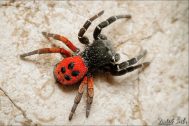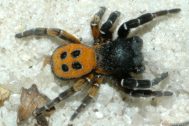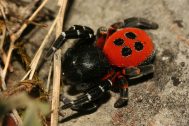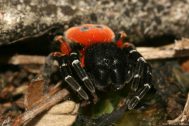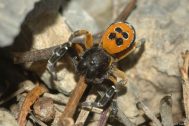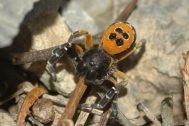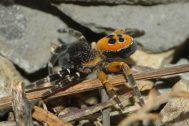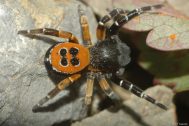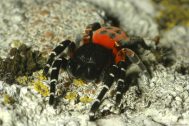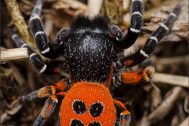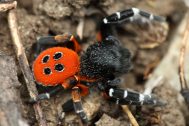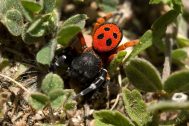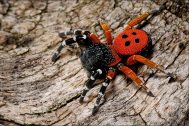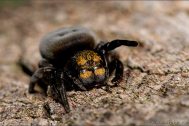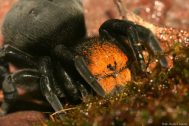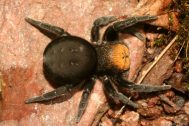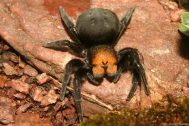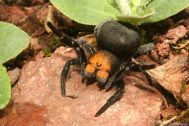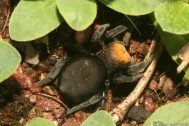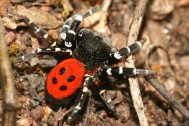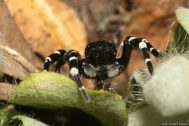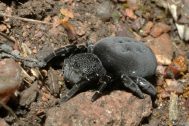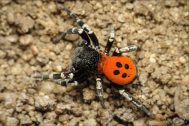| Records by time | |||||
|---|---|---|---|---|---|
| Eresidae | 0-1900 | 1901-1950 | 1951-2000 | 2001+ | ∑ |
 Eresus hermani
Kovács, Prazsák, Eichardt, Vári & Gyurkovics, 2015 Criticaly endangered Eresus hermani
Kovács, Prazsák, Eichardt, Vári & Gyurkovics, 2015 Criticaly endangered |
2× | 2× | |||
 Eresus kollari
Rossi, 1846 Endangered Eresus kollari
Rossi, 1846 Endangered |
2× | 12× | 167× | 43× | 224× |
 Eresus moravicus
Řezáč, 2008 Criticaly endangered Eresus moravicus
Řezáč, 2008 Criticaly endangered |
13× | 23× | 36× | ||
 Eresus sandaliatus
(Martini & Goeze, 1778) Criticaly endangered Eresus sandaliatus
(Martini & Goeze, 1778) Criticaly endangered |
8× | 7× | 15× | ||
Bibliography
Potravní biologie stepníkovitých pavouků.
Práce se zabývá potravním spektrem stepníkovitých pavouků, kdy se u nás vyskytují pouze zástupci rodu Eresus sp.. V práci jsem zkoumal potravní biologii druhu Eresus kollari. Při určování typu kořisti jsem využíval techniku zemních pastí, laboratorního pozorování, analýzu skeletálních zbytků z pavučin a nedílnou součástí byla analýza již publikované odborné literatury a internetových zdrojů. Čeled Eresidae zahrnuje celkem 9 rodů a celkově více než 100 druhů. Těžiště výskytu druhů pavouků čeledi Eresidae je zejména na území Afriky, kde obývají suché a teplé biotopy. Všechny rody čeledi využívají pro stavbu svých pavučin kribelátní vlákno. Své sítě si staví buď na povrchu půdy nebo ve vegetaci. U pozemních druhů stepníků je nora vždy v horní části tvořena pavučinovou stříškou a dolní část tvoří vertikálně umístěná nora, ve které tráví pavouk většinu svého života. Rod Stegodyphus sp. si buduje své sítě ve vegetaci, kdy se živí spíše hmyzem, který je schopný letu. V celkovém pohledu se stepníkovití pavouci (Eresidae) živí brouky (Coleoptera) a mravenci (Formicidae), ale nepohrdnou téměř čímkoliv, co uvízne v jejich sítích na dostatečně dlouhou dobu. Aktivní jsou po celou dobu dne a pro kořist vyrážejí ihned po kontaktu kořistí s vlákny pavučiny.
Výsledky faunistického průzkumu pavouků a sekáčů na vybraných lokalitách na území NP Podyjí v roce 2020
Spider conservation in Europe: a review
Despite their ecological importance and diversity, spiders (Arachnida: Araneae) are underrepresented in conservation policies in comparison to other groups. We review all extant conservation tools focusing on spiders in Europe, highlighting general patterns, limitations, gaps, and future directions. We assembled a comprehensive online database reporting all available information concerning the legal protection and conservation status of 4,154 spider species. Existing international legislation has limited coverage, with only one species listed in the Bern Convention and EU Habitats Directive. At the national and subnational levels, 178 species are formally mentioned in the legislation of 19 European countries. Moreover, the International Union for Conservation of Nature (IUCN) includes assessments for 301 species worldwide, 164 of these threatened and eight native to Europe. In addition, spiders are mentioned in Regional Red Lists and Red Books in 28 out of 42 European countries considered in this review. Northern and Central European countries have the highest percentage of species assessed at the regional level in Red Lists and Red Books. The Mediterranean basin has the highest spider diversities in Europe but conservation efforts are lacking, both in terms of assessments and national or subnational legislation. Among European species, Dolomedes plantarius, Argyroneta aquatica and Eresus kollari are the most frequently mentioned in European conservation measures, possibly due to their ecological traits and their strict association with declining habitats. Considering the current threats to spiders in Europe, the protection of large areas of suitable habitat should be considered as the most effective approach to spider conservation.Stepník černonohý na Manětínsku
Stepníci patří mezi velmi zajímavé druhy pavoučí fauny a to jak kvůli svému vzhledu, tak i vzácnosti (až na stepníka rudého jsou všichni řazeni mezi kriticky ohrožené druhy). Dá se dokonce říct, že jsou ikonou některých stepních lokalit na území České republiky. Jejich dobrým identifikačním znakem je u samců zářivě zbarvený zadeček se čtyřmi černými puntíky – to je příležitost k jednoznačnému určení i pro laiky. Samice je sice větší (až do 1,5 cm), má ale pouze jednolité černé zbarvení.Výsledky faunistického průzkumu pavouků a sekáčů na vybraných lokalitách na území NP Podyjí v roce 2019
A total of 114 spider species from 25 families and one harvestmen species were found during the zoological research at several sites in the Podyjí National Park during 2019. Of them, forty-one species are listed in the Red List of spiders of the Czech Republic. Four new species for the Podyjí NP were recorded – Callilepis nocturna (Linnaeus, 1758), Euryopis laeta (Westring, 1861), Phrurolithus minimus C. L. Koch, 1839 and Trichoncus auritus (L. Koch, 1869). Among the most interesting species, four critically endangered spiders – Civizelotes caucasius (L. Koch, 1866), Phrurolithus szilyi Herman, 1879, Gnaphosa modestior Kulczyński, 1897 and Eresus moravicus Řezáč, 2008 should be mentioned. Other rare species include Acartauchenius scurrilis (O. Pickard-Cambridge, 1873), Agyneta fuscipalpa (C. L. Koch, 1836), Arctosa figurata (Simon, 1876), Atypus affinis Eichwald, 1830, Bassaniodes robustus (Hahn, 1832), Callilepis schuszteri (Herman, 1879), Centromerus incilium (L. Koch, 1881), Centromerus leruthi Fage, 1933, Cheiracanthium effossum Herman, 1879, Drassyllus villicus (Thorell, 1875), Euryopis quinqueguttata Thorell, 1875, Frontinellina frutetorum (C. L. Koch, 1835), Gibbaranea gibbosa (Walckenaer, 1802), Gnaphosa opaca Herman, 1879, Haplodrassus cognatus (Westring, 1861), Haplodrassus dalmatensis (L. Koch, 1866), Haplodrassus minor (O. Pickard-Cambridge, 1879), Heterotheridion nigrovariegatum (Simon, 1873), Kishidaia conspicua (L. Koch, 1866), Leptorchestes berolinensis (C. L. Koch, 1846), Minicia marginella (Wider, 1834), Phrurolithus pullatus Kulczyński, 1897, Trichopterna cito (O. Pickard-Cambridge, 1873), Walckenaeria simplex Chyzer, 1894, Zelotes erebeus (Thorell, 1871) and Zora manicata Simon, 1878.Výsledky faunistického průzkumu pavouků a sekáčů na vybraných lokalitách na území NP Podyjí v roce 2019
A total of 114 spider species from 25 families and one harvestmen species were found during the zoological research at several sites in the Podyjí National Park during 2019. Of them, forty-one species are listed in the Red List of spiders of the Czech Republic. Four new species for the Podyjí NP were recorded – Callilepis nocturna (Linnaeus, 1758), Euryopis laeta (Westring, 1861), Phrurolithus minimus C. L. Koch, 1839 and Trichoncus auritus (L. Koch, 1869). Among the most interesting species, four critically endangered spiders – Civizelotes caucasius (L. Koch, 1866), Phrurolithus szilyi Herman, 1879, Gnaphosa modestior Kulczyński, 1897 and Eresus moravicus Řezáč, 2008 should be mentioned. Other rare species include Acartauchenius scurrilis (O. Pickard-Cambridge, 1873), Agyneta fuscipalpa (C. L. Koch, 1836), Arctosa figurata (Simon, 1876), Atypus affinis Eichwald, 1830, Bassaniodes robustus (Hahn, 1832), Callilepis schuszteri (Herman, 1879), Centromerus incilium (L. Koch, 1881), Centromerus leruthi Fage, 1933, Cheiracanthium effossum Herman, 1879, Drassyllus villicus (Thorell, 1875), Euryopis quinqueguttata Thorell, 1875, Frontinellina frutetorum (C. L. Koch, 1835), Gibbaranea gibbosa (Walckenaer, 1802), Gnaphosa opaca Herman, 1879, Haplodrassus cognatus (Westring, 1861), Haplodrassus dalmatensis (L. Koch, 1866), Haplodrassus minor (O. Pickard-Cambridge, 1879), Heterotheridion nigrovariegatum (Simon, 1873), Kishidaia conspicua (L. Koch, 1866), Leptorchestes berolinensis (C. L. Koch, 1846), Minicia marginella (Wider, 1834), Phrurolithus pullatus Kulczyński, 1897, Trichopterna cito (O. Pickard-Cambridge, 1873), Walckenaeria simplex Chyzer, 1894, Zelotes erebeus (Thorell, 1871) and Zora manicata Simon, 1878.Habitat selection by threatened burrowing spiders (Araneae: Atypidae, Eresidae) of central Europe: evidence base for conservation management.
Habitat selection in sedentary, long-lived burrowing spiders is a key life-history event that directly affects their reproductive success. In this study, we analyzed the role of the chemical and physical properties of soil in habitat selection by threatened temperate burrowing spiders. We examined 296 burrows of three Atypus spp. and three Eresus spp. at 68 sites in Czechia. We found that the study species were associated with soils that have high or very high cation exchange capacity, which allows the presence of a stable nd humid microclimate in their burrows. We found that specific bedrock types can be used as predictors of the presence of particular study species. All Eresus spp. avoided compacted soils. However, when present in soils with very low penetration resistance, they were limited to sites with high soil cohesion. The burrows of all study species were located at well-drained sites. The study species seemed to be selective for a steppe-like character of their microhabitat but not necessarily for its southward orientation. We found the study species even at sites where steppes were present in the early 1950s and that underwent later afforestation but not extensive landscaping or plowing. What types of disturbances can be sustained by the study species and how long it takes the decreased populations to recover after, e.g., trampling associated with grazing, remain to be investigated.
Zajímavý nález Eresus sandaliatus Martini et Goetze, 1778 z Černockého vrchu u Malé Černoce na Podbořansku (severozápadní Čechy).
Eresus sandaliatus je vzácný druh pavouka z čeledi stepníkovitých (Eresidae), jenž je řazen mezi kriticky ohrožené druhy (CR) naší arachnofauny (Ř EZÁČ et al. 2015). Během floristického průzkumu Podbořanska v průběhu května 2015 jsme učinili zajímavý nález samce tohoto stepníka na Černockém vrchu u Malé Černoce. Tento taxon dosud nebyl ze sledovaného území znám.
Morfologické a histologické adaptace reprodukčních a snovacích orgánů araneomorfních pavouků.
S výjimkou velkých ampulovitých žláz je výzkum všech ostatních typů pavoučích snovacích žláz značně opomíjen. Porozumění snovacímu aparátu pavouků však vyžaduje mnohem komplexnější znalosti nejen morfologie různých typů snovacích žláz, ale také vlastností produkovaných vláken a jejich využití v nejrůznějších situacích, především při lovu kořisti. Morfologický a histologický výzkum nezaostává pouze v otázce snovacích žláz. Jen málo studií se zabývalo ultrastrukturou a významem měkkých tkání v okolí kopulačních orgánů pavouků. Stepníci hrají díky svému fylogeneticky bazálnímu postavení mezi entelegynními pavouky zásadní roli a stavba jejich kopulačních orgánů může hrát důležitou roli ve snaze porozumět vývoji entelegynních pavouků.
V rámci předkládané disertační práce jsme se pokusili zodpovědět následující otázky: (1) Jaká je morfologická a histologická struktura kopulačních orgánů u stepníka rudého (Eresus kollari)? (2) Jak se liší morfologie malých a velkých ampulovitých žláz u kribelátních a nekribelátních pavouků a jaká je jejich funkce? (3) Jaká je morfologie piriformních snovacích žláz u čeledi Gnaphosidae a k čemu slouží a jaké vlastnosti má vlákno produkované těmito žlázami?
Pomocí světelné a elektronové mikroskopie jsme zkoumali morfologickou stavbu samičích kopulačních orgánů a histologické charakteristiky okolních tkání stepníka rudého (Eresus kollari). Nalezli jsme dva typy pórů asociovaných s různými částmi kopulačních orgánů: (1) na anteriorních výdutích se vyskytující malé množství velkých pórů a (2) na spermatékách se vyskytující velké množství velmi malých pórů. Kolem těchto pórů jsme nalezli dva typy epitelu. Anteriorní výdutě jsou obklopeny epitelem, který je složen z glandulárních jednotek Třídy 3, zatímco spermatéky jsou obklopeny transportním epitelem, který je charakteristický nápadným basálním labyrintem a apikálním komplexem nesoucím velké množství mikrovily.
Vlákna malých ampulovitých žláz jsou u kribelátních pavouků využívány k formování adhezivního komplexu, který slouží k lovu kořisti. Malé ampulovité žlázy se ovšem zachovaly i u nekribelátních skupin pavouků, kde se adaptovaly k jiné činnosti. V této práci srovnáváme morfologii velkých a malých ampulovitých žláz u příbuzných kribelátních a nekribelátních čeledí v rámci nadčelediAmaurobioidea. Zjistili jsme, že u kribelátních zástupců jsou malé ampulovité žlázy velmi často vidlicovitě větvené. Toto větvení může hrát důležitou roli při formování kribelátního adhezivního svazku.
U čeledi Gnaphosidae jsme se zaměřili na výzkum piriformních snovacích žláz. U této čeledi jsou piriformní žlázy včetně jejich spigotů oproti běžné situaci výrazně zvětšené. Důvodem této morfologické adaptace je důležitá role těchto žláz při lovu kořisti. Vlákno produkované těmito žlázami má silné adhezivní vlastnosti a zároveň je dostatečně pevné s vysokou elasticitou a houževnatostí. Vlákno s těmito vlastnostmi je tak ideální pro lov a imobilizaci kořisti.
Příspěvek k výskytu sklípkánka Atypus muralis Bertkau, 1890 a stepníka Eresus kollari Rossi, 1846 na Prostějovsku.
Příspěvek pojednává o nálezu izolované populace Atypus muralis a Eresus kollari na Prostějovsku.Taxonomic review and phylogenetic analysis of central European Eresus species (Araneae: Eresidae)
Ladybird spiders (Eresus spp.) have attracted scientific interest since the 18th century, but taxonomical knowledge of the genus is unsatisfactory. Early classification based on colour and size variation divided European Eresus into numerous species. These were later lumped into one predominant morphospecies, Eresus niger/E. cinnaberinus, which could be found from Portugal to Central Asia. Here, we perform a major revision of Eresus from northern and central Europe using morphological, phenological, habitat, distribution and molecular data. Three species, Eresus kollari, Eresus sandaliatus and Eresus moravicus sp. n. were distinguished. The name E. niger (originally Aranea nigra) cannot be used as the name A. nigra was used for a previous spider species. The name E. cinnaberinus is considered a nomen dubium. The three species differ in size, colour pattern, shape of prosoma and copulatory organs, phenology, and have slightly different habitat requirements. No morphologically intermediate forms were recorded. In contrast to distinct morphology and phenology, the genus is genetically complex. Genetically, the mitochondrial haplotypes of Eresus sandaliatus and Eresus moravicus sp. n. are monophyletic, whereas those of Eresus kollari are paraphyletic. Eastern central European Eresus kollari is likely a hybrid lineage between Eresus sandaliatus and the monophyletic western central European Eresus kollari. Because eastern and western European Eresus kollari are morphologically and phenologically indistinguishable, we did not formally split them. However, detailed population-based research in the future may partition Eresus kollari into additional species.
Gallery
Eresus hermani
Eresus kollari
Eresus moravicus
Eresus sandaliatus
Statistics
By month
By altitude
By collecting method (276 used records)
| Zemní past | Males | Females | Juveniles | Records |
|---|---|---|---|---|
| Eresus kollari Rossi, 1846 | 340 | 10 | 27 | 89 |
| Eresus moravicus Řezáč, 2008 | 73 | 3 | 14 | 17 |
| Eresus sandaliatus (Martini & Goeze, 1778) | 3 | 0 | 0 | 1 |
| Individuální sběr | Males | Females | Juveniles | Records |
| Eresus kollari Rossi, 1846 | 119 | 16 | 9 | 52 |
| Eresus moravicus Řezáč, 2008 | 5 | 1 | 0 | 6 |
| Eresus sandaliatus (Martini & Goeze, 1778) | 13 | 2 | 0 | 7 |
| Neurčeno | Males | Females | Juveniles | Records |
| Eresus kollari Rossi, 1846 | 87 | 12 | 3 | 51 |
| Eresus moravicus Řezáč, 2008 | 15 | 2 | 0 | 7 |
| Eresus sandaliatus (Martini & Goeze, 1778) | 5 | 3 | 1 | 7 |
| Fotografie | Males | Females | Juveniles | Records |
| Eresus hermani Kovács, Prazsák, Eichardt, Vári & Gyurkovics, 2015 | 1 | 0 | 6 | 2 |
| Eresus kollari Rossi, 1846 | 6 | 2 | 0 | 7 |
| Eresus moravicus Řezáč, 2008 | 11 | 1 | 0 | 2 |
| Prosev | Males | Females | Juveniles | Records |
| Eresus kollari Rossi, 1846 | 5 | 4 | 3 | 11 |
| Smyk | Males | Females | Juveniles | Records |
| Eresus kollari Rossi, 1846 | 1 | 0 | 0 | 10 |
| Pozorování | Males | Females | Juveniles | Records |
| Eresus kollari Rossi, 1846 | 14 | 0 | 0 | 2 |
| Eresus moravicus Řezáč, 2008 | 7 | 1 | 0 | 4 |
| Sklepávání | Males | Females | Juveniles | Records |
| Eresus kollari Rossi, 1846 | 1 | 0 | 0 | 1 |
| Males | Females | Juveniles | Records |
By biotope (276 used records)
| Neurčeno | Males | Females | Juveniles | Records |
|---|---|---|---|---|
| Eresus kollari Rossi, 1846 | 59 | 24 | 15 | 88 |
| Eresus moravicus Řezáč, 2008 | 35 | 2 | 8 | 18 |
| Eresus sandaliatus (Martini & Goeze, 1778) | 8 | 2 | 1 | 9 |
| Skalní stepi na vápenci | Males | Females | Juveniles | Records |
| Eresus hermani Kovács, Prazsák, Eichardt, Vári & Gyurkovics, 2015 | 1 | 0 | 6 | 2 |
| Eresus kollari Rossi, 1846 | 76 | 5 | 4 | 38 |
| Eresus moravicus Řezáč, 2008 | 53 | 2 | 6 | 9 |
| Suché louky | Males | Females | Juveniles | Records |
| Eresus kollari Rossi, 1846 | 139 | 3 | 16 | 36 |
| Lesostepní doubravy | Males | Females | Juveniles | Records |
| Eresus kollari Rossi, 1846 | 206 | 1 | 3 | 15 |
| Eresus moravicus Řezáč, 2008 | 5 | 2 | 0 | 3 |
| Eresus sandaliatus (Martini & Goeze, 1778) | 9 | 0 | 0 | 2 |
| Travnaté stepi | Males | Females | Juveniles | Records |
| Eresus kollari Rossi, 1846 | 17 | 1 | 0 | 6 |
| Eresus moravicus Řezáč, 2008 | 11 | 1 | 0 | 2 |
| Eresus sandaliatus (Martini & Goeze, 1778) | 3 | 1 | 0 | 2 |
| Porosty borůvek | Males | Females | Juveniles | Records |
| Eresus kollari Rossi, 1846 | 15 | 0 | 1 | 7 |
| Skalní stepi na jiných horninách | Males | Females | Juveniles | Records |
| Eresus kollari Rossi, 1846 | 6 | 2 | 0 | 5 |
| Eresus sandaliatus (Martini & Goeze, 1778) | 1 | 2 | 0 | 2 |
| Xerotermní travinobylinná společenstva | Males | Females | Juveniles | Records |
| Eresus kollari Rossi, 1846 | 2 | 2 | 2 | 6 |
| Písčiny | Males | Females | Juveniles | Records |
| Eresus kollari Rossi, 1846 | 1 | 3 | 0 | 4 |
| Eresus moravicus Řezáč, 2008 | 1 | 0 | 0 | 1 |
| Jeskyně | Males | Females | Juveniles | Records |
| Eresus kollari Rossi, 1846 | 4 | 1 | 0 | 4 |
| Rašeliniště | Males | Females | Juveniles | Records |
| Eresus kollari Rossi, 1846 | 20 | 1 | 0 | 4 |
| Vřesoviště nižších poloh | Males | Females | Juveniles | Records |
| Eresus kollari Rossi, 1846 | 14 | 0 | 0 | 4 |
| Stinné skály nižších poloh | Males | Females | Juveniles | Records |
| Eresus kollari Rossi, 1846 | 2 | 0 | 1 | 2 |
| Suché křoviny | Males | Females | Juveniles | Records |
| Eresus kollari Rossi, 1846 | 1 | 1 | 0 | 2 |
| Zahrady | Males | Females | Juveniles | Records |
| Eresus moravicus Řezáč, 2008 | 0 | 1 | 0 | 1 |
| Kamenolomy | Males | Females | Juveniles | Records |
| Eresus kollari Rossi, 1846 | 2 | 0 | 0 | 1 |
| Ruderály | Males | Females | Juveniles | Records |
| Eresus moravicus Řezáč, 2008 | 1 | 0 | 0 | 1 |
| Suché lesní lemy | Males | Females | Juveniles | Records |
| Eresus kollari Rossi, 1846 | 9 | 1 | 0 | 1 |
| Pastviny | Males | Females | Juveniles | Records |
| Eresus kollari Rossi, 1846 | 1 | 0 | 0 | 1 |
| Males | Females | Juveniles | Records |















